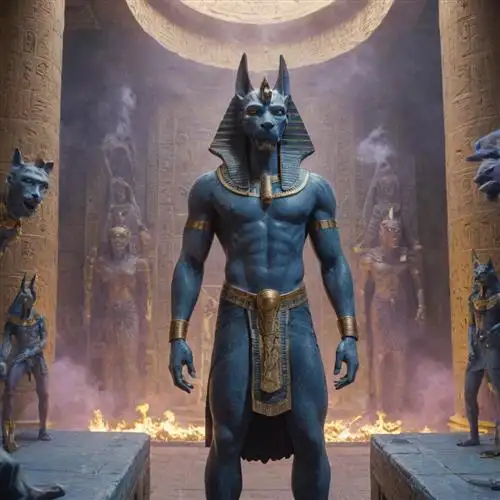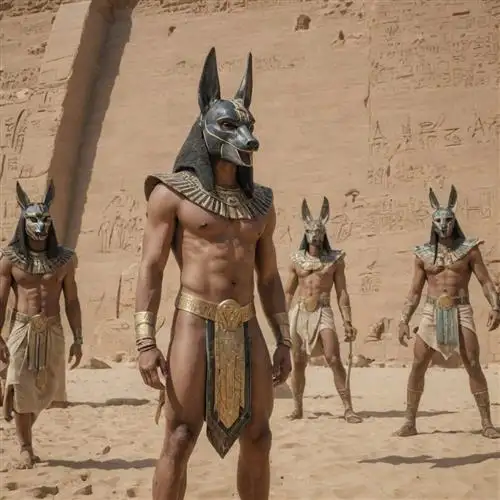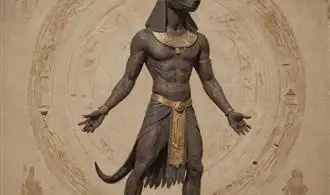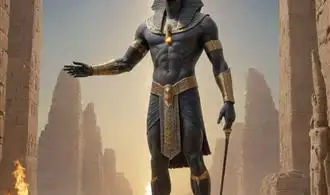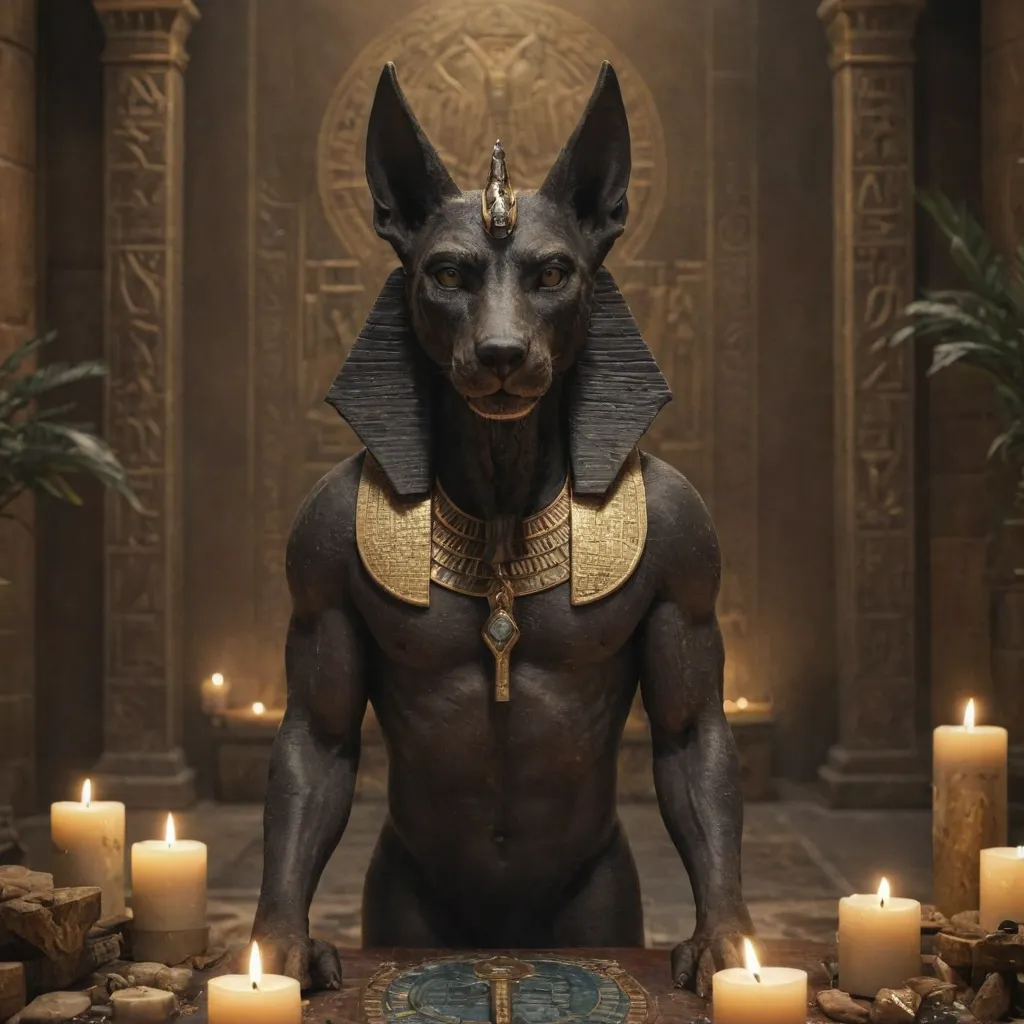
The Mysteries of Anubis Worship
Anubis, the jackal-headed god of the ancient Egyptian pantheon, held a profound and multifaceted role in the mystical rituals and beliefs of the Nile civilization. As the patron deity of mummification and the afterlife, Anubis' influence permeated the intricate tapestry of religious practices and funerary rites that defined the Egyptian worldview.
At the heart of Anubis worship lay the mysteries of the embalming process, a sacred ritual that ensured the safe passage of the deceased into the afterlife. The jackal-god was believed to oversee this delicate procedure, guiding the soul and safeguarding the body as it underwent the transformative journey from mortal to immortal. The mummification process, with its meticulous attention to detail and symbolic significance, was seen as a reflection of Anubis' own role as the gatekeeper between the realms of the living and the dead.
Beyond the embalming chamber, Anubis' rituals extended into the realm of the afterlife. As the psychopomp, or guide of souls, Anubis was believed to escort the deceased to the Hall of Judgment, where the heart of the individual was weighed against the feather of Ma'at, the goddess of truth and justice. This pivotal moment in the journey of the soul was a crucial step in determining the ultimate fate of the individual, as Anubis guided the deceased through the intricate tapestry of the afterlife.
The veneration of Anubis also incorporated a rich tapestry of symbolic imagery and iconography. The jackal-headed deity was often depicted holding the was scepter, a symbol of power and authority, and the ankh, the hieroglyphic sign for life. These visual representations not only conveyed the god's role in the afterlife but also served as talismans, invoked by the living to seek Anubis' protection and guidance.
Rituals dedicated to Anubis often involved the use of specialized tools and artifacts, such as the canopic jars used to store the deceased's vital organs during mummification. These objects, imbued with sacred significance, were believed to assist the soul in its journey through the underworld, with Anubis overseeing their proper use and placement.
The mysteries of Anubis worship were not limited to the physical realm but also extended into the realm of the metaphysical. The jackal-god was associated with the stars and the night sky, and his rituals often incorporated astrological symbolism and celestial imagery. This connection to the heavens reinforced Anubis' role as a guardian of the afterlife, guiding the souls of the deceased through the celestial realms.
Divination and Rites of Passage
Divination and Rites of Passage with Anubis hold profound significance in the ancient Egyptian spiritual tradition. As the god of the dead, embalming, and the underworld, Anubis played a crucial role in the transition from life to the afterlife. Through carefully crafted rituals and divination practices, the ancient Egyptians sought to commune with Anubis, seeking guidance, protection, and a safe passage into the eternal realm.
Anubis was believed to preside over the weighing of the heart ceremony, where the deceased's heart was weighed against the feather of truth. This pivotal ritual determined whether the individual was worthy of entering the afterlife, with Anubis overseeing the proceedings. By aligning themselves with Anubis through ritual and devotion, the ancient Egyptians hoped to ensure a favorable outcome in this critical judgment.
Divination practices associated with Anubis often involved the interpretation of dreams and omens. The ancient Egyptians believed that Anubis could communicate with the living through dreams, providing guidance, warnings, and insights into the afterlife. Practitioners of these divination rites would carefully analyze dream symbols and signs, seeking to uncover the messages and wisdom imparted by the god of the dead.
Rites of passage, such as the mummification process and funerary ceremonies, were also deeply intertwined with the veneration of Anubis. The jackal-headed deity was believed to oversee the embalming and preparation of the deceased, ensuring a proper and sacred journey into the afterlife. Through these rituals, the ancient Egyptians sought to secure the protection and guidance of Anubis, ensuring a smooth transition for the departed soul.
Mummification and the Afterlife
The ancient Egyptians believed that the mummification process was crucial for ensuring a smooth transition into the afterlife. At the heart of this ritual was the figure of Anubis, the jackal-headed god who presided over the embalming and protection of the deceased. Understanding the intricate details of mummification and its connection to the afterlife is essential for unlocking the deeper secrets of Anubis rituals.
The mummification process was a meticulously orchestrated procedure that required the expertise of a team of specialized priests and embalmers. The body would be carefully cleansed, dehydrated, and wrapped in linen bandages, with various amulets and talismans placed strategically to protect the deceased. The role of Anubis was paramount, as he was believed to guide the soul through the complex journey to the afterlife.
One of the most significant aspects of Anubis rituals was the weighing of the heart ceremony. This ritual, known as the "Weighing of the Heart," involved placing the deceased's heart on a scale and measuring it against the feather of Ma'at, the goddess of truth and justice. If the heart was deemed pure and free from sin, the soul was granted passage to the afterlife. Anubis, as the guardian of this ceremony, played a crucial role in determining the fate of the deceased.
The afterlife in ancient Egyptian belief was a complex and multifaceted concept, and Anubis was central to this understanding. The deceased were believed to embark on a journey through the underworld, guided by Anubis, where they would encounter various challenges and obstacles. The successful completion of these trials would allow the soul to reach the ultimate goal of eternal life in the realm of the gods.
Rituals associated with Anubis, such as the Opening of the Mouth ceremony, were designed to ensure the deceased's ability to speak, eat, and function in the afterlife. These intricate ceremonies, performed by the priests of Anubis, were believed to awaken the senses of the mummified body and prepare the soul for its journey to the afterlife.
Anubis in Modern Spiritual Practices
Anubis, the jackal-headed Egyptian god, has remained a captivating figure in modern spiritual practices. As the deity associated with mummification, the afterlife, and the mysteries of the dead, Anubis continues to hold a prominent place in the beliefs and rituals of those seeking a deeper connection with the divine and the unknown. In this section, we will explore the ways in which Anubis is honored and invoked in contemporary spiritual traditions.
One of the primary ways Anubis is integrated into modern practices is through meditation and visualization. Many practitioners find that focusing on the powerful imagery of the jackal-headed god can facilitate a profound state of introspection and connection with the realms of the afterlife. By visualizing Anubis, individuals may seek guidance, wisdom, and protection as they navigate the mysteries of death, transition, and transformation.
Additionally, Anubis is often featured in ceremonial and ritual work, particularly within Pagan, Wiccan, and Hermetic traditions. Practitioners may invoke Anubis during funerary rites, rites of passage, or when working with themes of death, rebirth, and the underworld. The rituals may involve the use of Anubis-related symbolism, such as statues, candles, or incense, to create a sacred space and facilitate a deeper connection with the deity.
Another way Anubis is incorporated into modern spiritual practices is through the use of talismans and amulets. These objects, often featuring the image or likeness of Anubis, are believed to offer protection, guidance, and a conduit for the god's energies. Individuals may wear or carry these items as a means of invoking Anubis' presence and influence in their daily lives.

